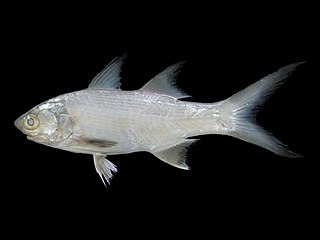
Threadfins are silvery grey perciform fish of the family Polynemidae. Found in tropical to subtropical waters throughout the world, the threadfin family contains eight genera and about 40 species. An unrelated species sometimes known by the name threadfin, Alectis indicus, is properly the Indian threadfish.

The Australian herring, also known as the ruff, tommy ruff, or Australian ruff, is one of four Australasian fish species within the genus Arripis. It closely resembles its sister species, the Australian salmon, although it grows to a smaller size. Like the other members of its genus, it is found in cooler waters around the southern coast of Australia. It is not biologically related to the herring family Clupeidae.

The Atlantic threadfin is a species of ray-finned fish a threadfin from the family Polynemidae which is native to subtropical and temperate waters of the western Atlantic Ocean and the Gulf of Mexico.

The speartooth shark is an extremely rare species of river shark, belonging to the family Carcharhinidae. It inhabits coastal marine waters and tidal reaches of large tropical rivers in northern Australia and New Guinea. Despite being a member of the river shark genus, it is also found in near-shore marine waters, favoring highly turbid environments over a wide range of salinities. This robustly built, gray-colored shark is characterized by a short and broad snout, tiny eyes, a relatively large second dorsal fin, and a black blotch beneath each pectoral fin near the tip. Another identifying trait is its teeth, which are large, triangular, and serrated in the upper jaw and narrow, spear-like, and serrated only near the tips in the lower jaw. Adults grow to about 2.6 m (8.5 ft) long.

Eleutheronema tetradactylum, the fourfinger threadfin, is a species of marine ray-finned fish, a threadfin from the family Polynemidae which occurs in the Indian and western Pacific Ocean.

The duskyshoulder trevally or epaulet trevally, is a species of small inshore marine fish in the jack family, Carangidae. It is distributed through the eastern Indian and western Pacific Oceans, ranging from eastern India to northern Australia and Taiwan. It is relatively small by carangid standards, reaching only 27 cm maximum length, and can be distinguished by the large, black blotches on its shoulders. The duskyshoulder trevally is an inshore fish living in waters less than 50 m deep, over sandy substrates in bays and on the continental shelf. It is a predatory fish, taking demersal fishes, crustaceans, and cephalopods, with nothing known of its reproductive habits. It is of little value to fisheries, often taken as bycatch in prawn trawling operations.

The giant African threadfin is a species of ray-finned fish from the threadfin family Polynemidae. It is found in the eastern Atlantic Ocean off the west coast of Africa.

Polydactylus sexfilis, the six-finger threadfin or yellowthread threadfin, is a species of marine ray-finned fish, a threadfin from the family Polynemidae which is found in the Indian and Pacific Oceans.

The false scorpionfish, also known as prettyfins, is a species of perciform fish, the only species in genus Centrogenys, which in turn is the only genus in the family Centrogenyidae. They are pale grey or brown and usually grow no longer than 25 cm (9.8 in). False scorpionfish are distributed throughout the Indo-West Pacific, bounded by the Ryukyu Islands of Japan to the north and Australia to the south, the Nicobar Islands to the west and New Guinea to the east.

The longfin grouper, also known as the longfin rockcod, bar-breasted rock-cod, Gilbert's rock-cod, honeycomb rockcod, spotted groper or wirenet cod, is a species of marine ray-finned fish, a grouper from the subfamily Epinephelinae which is part of the family Serranidae, which also includes the anthias and sea basses. It is found in the Western Pacific Ocean.

The Indian threadfin is a species of marine ray-finned fish from the family Polynemidae, the threadfins. It is a coastal species from south-east Asia which has been recorded in Papua New Guinea.

Polynemus multifilis, the elegant paradise fish is a species of ray-finned fish, a threadfin from the family Polynemidae which is found in rivers in southeast Asia.
Polynemus aquilonaris, commonly known as the northern paradise fish, is a fish of the threadfin family Polynemidae. It is native to the large rivers of mainland Southeast Asia.

Polydactylus sextarius, the blackspot threadfin, is a species of marine ray-finned fish, a threadfin from the family Polynemidae which is native to the western Pacific and eastern Indian Oceans.

Polydactylus plebeius, the striped threadfin, also known as the common threadfin, Northern threadfin or puttynose, is a species of marine fish native to the Indo-Pacific.
The dwarf paradise fish, also known as the streamer threadfin or streamered tasselfish, is a species of ray-finned fish from a family Polynemidae, the threadfins. It is the only species in the genus Parapolynemus and it is found in Australia and New Guinea.

The paradise threadfin is a species of catadromous ray-finned fish, a threadfin from the family Polynemidae which is found in south and southeast Asia in freshwater rivers where it is a valued food fish.

Filimanus is a genus of marine ray-finned fishes, threadfins from the family Polynemidae.

The lesser African threadfin is a species of marine ray-finned fish, a threadfin from the family Polynemidae which is found in the eastern Atlantic Ocean off the western coast of Africa.

The royal threadfin is a species of ray-finned fish, a threadfin from the family Polynemidae, the threadfins. It is found in the eastern Atlantic Ocean along the western coast of Africa.















